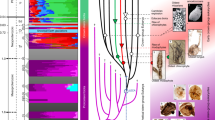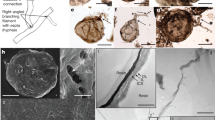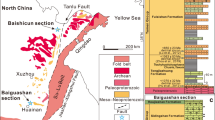Abstract
Molecular phylogeny and biogeochemistry indicate that eukaryotes differentiated early in Earth history. Sequence comparisons of small-subunit ribosomal RNA genes suggest a deep evolutionary divergence of Eukarya and Archaea1; C27–C29 steranes (derived from sterols synthesized by eukaryotes) and strong depletion of 13C (a biogeochemical signature of methanogenic Archaea) in 2,700 Myr old kerogens independently place a minimum age on this split2,3. Steranes, large spheroidal microfossils, and rare macrofossils of possible eukaryotic origin occur in Palaeoproterozoic rocks4,5,6. Until now, however, evidence for morphological and taxonomic diversification within the domain has generally been restricted to very late Mesoproterozoic and Neoproterozoic successions7. Here we show that the cytoskeletal and ecological prerequisites for eukaryotic diversification were already established in eukaryotic microorganisms fossilized nearly 1,500 Myr ago in shales of the early Mesoproterozoic Roper Group in northern Australia.
This is a preview of subscription content, access via your institution
Access options
Subscribe to this journal
Receive 51 print issues and online access
$199.00 per year
only $3.90 per issue
Buy this article
- Purchase on Springer Link
- Instant access to full article PDF
Prices may be subject to local taxes which are calculated during checkout



Similar content being viewed by others
References
Woese, C. R., Kandler, O. & Wheelis, M. L. Towards a natural system of organisms: proposal for the domains Archaea, Bacteria, and Eucarya. Proc. Natl. Acad. Sci. USA 87, 4576–4579 (1990).
Brocks, J. J., Logan, G. A., Buick, R. & Summons, R. E. Archean molecular fossils and the early rise of eukaryotes. Science 285, 1033–1036 (1999).
Hayes, J. M. in Early Life on Earth (ed. Bengtson, S.) 220–236 (Columbia Univ. Press, New York, 1994).
Zhang, Z. Clastic facies microfossils from the Chaunlingguo Formation (1800 Ma) near Jixian, North China. J. Micropalaeontol. 5, 9–16 (1986).
Summons, R. E., Powell, T. G. & Boreham, C. J. Petroleum geology and geochemistry of the Middle Proterozoic McArthur Basin, Northern Australia. III. Composition of extractable hydrocarbons. Geochim. Cosmochim. Acta 51, 3075–3082 (1988).
Han, T.-M. & Runnegar, B. Megascopic eukaryotic algae from the 2.1-billion-year-old Negaunee Iron Formation, Michigan. Science 257, 232–235 (1992).
Knoll, A. H. in Palynology: Principles and Applications (eds Jansonius, J. & McGregor, D. C.) Vol. I 51–80 (American Association of Stratigraphic Palynologists Foundation, Tulsa, Oklahoma, 1996).
Yin, L. Acanthomorphic acritarchs from Meso-Neoproterozoic shales of the Ruyang Group, Shanxi, China. Rev. Palaeobot. Palynol. 98, 15–25 (1998).
Butterfield, N. J., Knoll, A. H. & Swett, K. Paleobiology of the Neoproterozoic Svanbergfjellet Formation, Spitsbergen. Fossils Strata 34, 1–84 (1994).
Jansen, R.-P. RNA-cytoskeletal associations. FASEB J. 13, 455–466 (1999).
Schmidt, A. & Hall, M. N. Signalling the actin cytoskeleton. Annu. Rev. Cell Dev. Biol. 14, 305–338 (1998).
Xiao, S., Knoll, A. H., Kaufman, A. J., Yin, L. & Zhang, Y. Neoproterozoic fossils in Mesoproterozoic rocks? Chemostratigraphic resolution of a biostratigraphic conundrum from the North China Platform. Precambrian Res. 84, 197–220 (1997).
Jackson, M. J., Sweet, I. P., Page, R. W. & Bradshaw, B. E. in Integrated Basin Analysis of the Isa Superbasin Using Seismic, Well-log, and Geopotential Data: an Evaluation of the Economic Potential of the Northern Lawn Hill Platform (eds Bradshaw, B. E. & Scott, D. L.) (Australian Geological Survey Organisation Record 1999/19, Canberra, Australia, 1999).
Kralik, M. Rb–Sr age determinations on Precambrian carbonate rocks of the Carpentarian McArthur Basin, Northern Territory, Australia. Precambrian Res. 18, 157–170 (1982).
Abbott, S. T. & Sweet, L. P. Tectonic control on third-order sequences in a siliciclastic ramp-style basin: an example from the Roper Superbasin (Mesoproterozoic), northern Australia. Aust. J. Earth Sci. 47, 637–657 (2000).
Jackson, M. J. & Raiswell, R. Sedimentology and carbon-sulfur geochemistry of the Velkerri Formation, a mid-Proterozoic potential oil source in northern Australia. Precambrian Res. 54, 81–108 (1991).
Peat, C. R., Muir, M. D., Plumb, K. A., McKirdy, D. M. & Norvick, M. S. Proterozoic microfossils from the Roper Group, Northern Territory. Bur. Min. Res. J. Austr. Geol. Geophys. 3, 1–17 (1978).
Jankauskas, T. V. Precambrian microfossils from the USSR 5–33 (Nauka, Leningrad, 1989).
Veis, A. F. & Vorobyeva, N. G. Riphean and Vendian microfossils of the Anabar Uplift. Isvest. Akad. Nauk. USSR Ser. Geol. 8, 114–130 (1992).
Zhou, H. et al. Sequence Stratigraphic Research in Meso- to Neoproterozoic Successions of the Southern North China Platform 5–36 (Geological Publishing House, Beijing, 1999).
Jacobsen, S. R. Acritarchs as paleoenvironmental indicators in Middle and Upper Ordovician rocks from Kentucky, Ohio, and New York. J. Paleontol. 53, 1197–1212 (1979).
Vidal, G. & Nysteun, J. P. Micropaleontology, depositional environment, and biostratigraphy of the Upper Proterozoic Hedmark Group, southern Norway. Am. J. Sci. A 290, 170–211 (1990).
Butterfield, N. J. & Chandler, F. W. Palaeoenvironmental distribution of Proterozoic microfossils, with an example from the Agu Bay Formation, Baffin Island. Palaeontology 35, 943–957 (1992).
Petrov, P. Yu. & Veis, A. F. Facial-ecological structure of the Derevnya Formation microbiota: Upper Riphean, Turukhansk Uplift, Siberia. Stratigr. Geol. Correl. 3, 435–4605 (1995).
Canfield, D. E. A new model for Proterozoic ocean chemistry. Nature 396, 450–453 (1998).
Anbar, A. D. & Knoll, A. H. Trace metal limitation of primary production 1.85–1.25 Ga. 1999 American Geophysical Union Fall Meeting 〈http://www.agu.org/meetings/fm99top.html〉 (1999).
German, T. N. Organic World One Billion Years Ago 1–50 (Leningrad, Nauka, 1990).
Samuelsson, J., Dawes, P. R. & Vidal, G. Acid-resistant palynomorphs from the Proterozoic Thule Group, northwest Greenland. Precambrian Res. 96, 1–23 (1999).
Acknowledgements
This paper is a contribution to the Australian Geological Survey Organization's NABRE project. We thank J. Jackson, P. Southgate and other members of the NABRE team for access to unpublished observations, helpful discussions, and advice on sampling. Core library staff in Canberra (AGSO) and Darwin (Northern Territory Geological Survey) greatly facilitated sample collection. Y. Leiming provided information on Chinese stratigraphy. Research supported in part by a grant from NASA, the NASA Astrobiology Institute, the Australia Research Council, and Macquarie University.
Author information
Authors and Affiliations
Corresponding author
Rights and permissions
About this article
Cite this article
Javaux, E., Knoll, A. & Walter, M. Morphological and ecological complexity in early eukaryotic ecosystems. Nature 412, 66–69 (2001). https://doi.org/10.1038/35083562
Received:
Accepted:
Issue Date:
DOI: https://doi.org/10.1038/35083562
This article is cited by
-
Eukaryogenesis and oxygen in Earth history
Nature Ecology & Evolution (2022)
-
Molecular fossils within bitumens and kerogens from the ~ 1 Ga Lakhanda Lagerstätte (Siberia, Russia) and their significance for understanding early eukaryote evolution
PalZ (2021)
-
Precambrian and early Cambrian palaeobiology of India: Quo Vadis
Proceedings of the Indian National Science Academy (2021)
-
A New Record of Acanthomorphic Acritarch Tappania Yin from the Early Mesoproterozoic Saraipali Formation, Singhora Group, Chhattisgarh Supergroup, India and its Biostratigraphic Significance
Journal of the Geological Society of India (2019)
-
Ediacaran integrative stratigraphy and timescale of China
Science China Earth Sciences (2019)
Comments
By submitting a comment you agree to abide by our Terms and Community Guidelines. If you find something abusive or that does not comply with our terms or guidelines please flag it as inappropriate.



